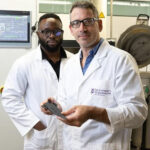After more than 50 years of the first moon landing, there is a new challenge for space missions. In fact, with the world increasingly focusing its attention on reaching new space milestones and overcoming technical boundaries, the space industry is rapidly looking to upgrade its spacesuit technology.
Specifically, spacesuits need better protection from the holes and scratches that are often caused by debris in space. With the collaboration of several partners, the International Lunar Exploration Working Group (ILEWG) is taking on this challenge. It aims to develop a spacesuit layer with a damage-detection system. And Teijin Aramid’s Twaron is proving an effective material for this prototype, thanks to its ballistic properties and conductivity.
Protecting from debris, detecting damage
In space, any impact from debris can be life-threatening to astronauts. Did you know that micrometeorites, in particular, travel 17 kilometers per second on average – faster than a typical bullet shot? Traditional spacesuits have not provided enough protection from this debris – and if it punctures a spacesuit, it can release air or cut the skin, making the wearer even more vulnerable. For astronauts’ safety, it is requested not only a protection from this debris, but also an alert system that can inform them of any damage that does occur to their spacesuits. What’s more, spacesuits also need to be lighter and more comfortable.
 To address these challenges, the ILEWG – a public forum to support the collaboration between several space agencies worldwide, including ESA, NASA, and CNES – is pioneering an impact-resistant extra-vehicular spacesuit layer with a damage-detection system.
To address these challenges, the ILEWG – a public forum to support the collaboration between several space agencies worldwide, including ESA, NASA, and CNES – is pioneering an impact-resistant extra-vehicular spacesuit layer with a damage-detection system.
Jamal Ageli, spacesuit design coordinator ILEWG, explains: “This project is a joint effort with several partners, including Royal Academy of Art The Hague, EuroMoonMars, ArtMoonMars, and institutions in France, Austria, and Switzerland.”
Remko Pol, Global Market Manager Aerospace, adds: “This collaborative, innovative project aligns perfectly with Teijin Aramid’s values. So, when the ILEWG contacted us in February 2020 to see whether Twaron’s ballistic and conductive properties could help them in their mission, we were on board straight away! With the spacesuit we are still in the earliest stages of this development, but we’re reaching for the moon.”
The material for the future spacesuit
Indeed, these properties are both proving very useful. Remko explains: “Around 150 hexagonal patches of the Twaron fabric we supply will be used in the suit layer.”
As well as forming an impact protection layer, each patch will also act as a damage-detection sensor to alert astronauts to stretches, holes, and scratches. The conductive yarn will send electrical signals to an in-built computing unit that measures any changes to the current. For example, if there is a puncture, the loss of conductivity will alert the wearer to the affected area. Combined with its low weight, these advantages make Twaron an ideal material for this project.
Maria Persson, Senior R&D Textile Expert, explains: “We supplied fabric solutions made from our finest filament yarn, Twaron Ultra Micro, for this prototype because they enable a high protection-to-comfort ratio. What’s more, by leveraging Twaron’s high-performance properties alongside conductive yarn to create a smart textile solution, the ILEWG may be able to reduce the number of protective layers required, for even greater comfort and mobility. To test the suit, astronauts will simulate space living for two weeks, assessing the suit’s comfort, performance, and power supply”.
Reaching for the moon
Now, the suit layer prototype is almost ready for testing. Jamal explains: “To test the suit, astronauts will simulate space living for two weeks, assessing the suit’s comfort, performance, and power supply. We’re focusing initially on the electronics and basic performance, so we can demonstrate that the concept works.”
The first round of tests will take place in the Alps in Switzerland, with future rounds planned in Hawaii, Iceland, and Poland.












